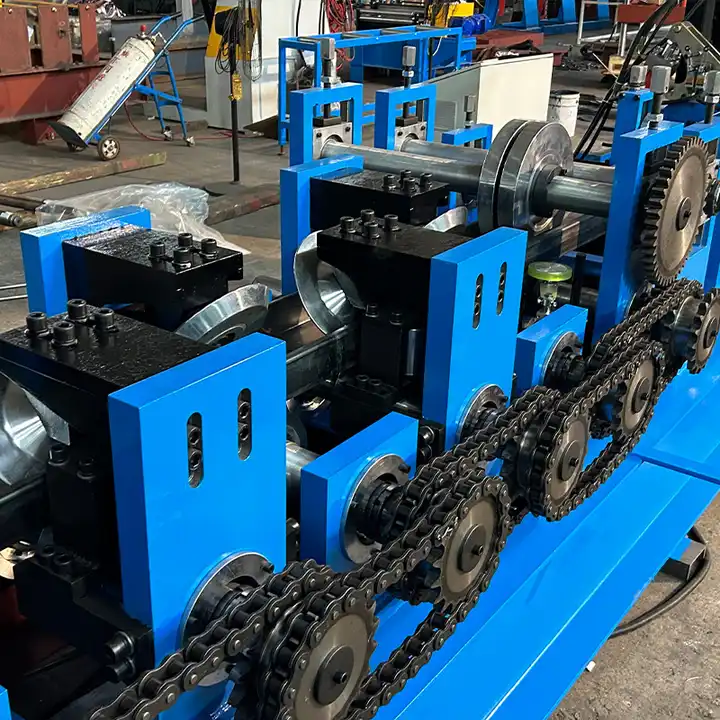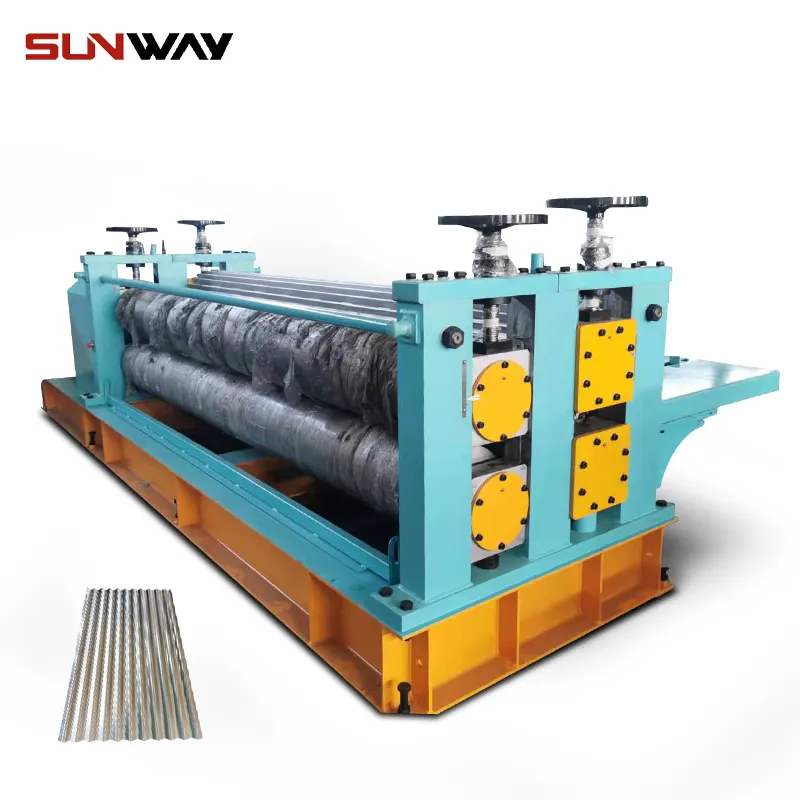When it comes to choosing the right roofing material for your home or commercial building, metal sheets are increasingly becoming a popular option. In this comprehensive guide, we will delve into everything you need to know about roofing with metal sheets. We will explore the different types of metal roofing, the roll forming process, key components, working process, machine efficiency, and much more. So, whether you’re a homeowner considering a metal roof or a contractor looking for more information, read on!
Overview of Roofs with Metal Sheets
Metal sheet roofing offers durability, longevity, and a modern aesthetic that other materials often can’t match. It’s an ideal choice for a wide range of climates and is known for its resistance to extreme weather conditions. Let’s break down the key points:
- Durability: Metal roofs can last 50 years or more with proper maintenance.
- Energy Efficiency: Reflects solar radiant heat, reducing cooling costs.
- Low Maintenance: Resistant to mold, mildew, and pests.
- Aesthetics: Available in various styles and colors to complement any architectural design.

Types of Roof with Metal Sheets
Understanding the different types of metal roofing materials can help you choose the best option for your needs. Here are some common types:
| Type | Description |
|---|---|
| Steel Roofing | Highly durable, coated with zinc or aluminum to prevent rust, available in a variety of finishes. |
| Aluminum Roofing | Lightweight, corrosion-resistant, and perfect for coastal areas. |
| Copper Roofing | Offers a unique aesthetic, develops a patina over time, and highly durable but expensive. |
| Zinc Roofing | Self-healing, corrosion-resistant, and offers a long lifespan. |
| Tin Roofing | Historical choice, less common today but still available for restoration projects. |
| Standing Seam | Vertical panels with clean lines, commonly used for modern homes and commercial buildings. |
| Metal Shingles | Mimic the look of traditional shingles, tiles, or slate while offering the benefits of metal. |
| Corrugated Metal | Wavy metal sheets, often used in agricultural and industrial applications. |
| Stone-coated Metal | Steel panels coated with stone granules, combining durability with a traditional appearance. |
| Galvalume Roofing | Combination of steel, aluminum, and zinc, offering excellent corrosion resistance and durability. |
Working Process of Roll Forming Machines for Metal Roofin
Roll forming is a continuous bending operation in which a long strip of metal (typically coiled steel) is passed through consecutive sets of rolls, each performing only an incremental part of the bend, until the desired cross-section profile is obtained.
- Decoiling: The metal coil is uncoiled and fed into the machine.
- Feeding: The metal strip is fed into the roll forming machine.
- रोल बनाना: Series of rollers shape the metal into the desired profile.
- Cutting: The formed metal is cut to the required length.
- Stacking: Finished products are stacked for transport.
| Component | Function |
|---|---|
| डेकोइलर | Unwinds the metal coil and feeds it into the machine. |
| Rollers | Bend the metal into the desired shape through consecutive forming stages. |
| Cutting Mechanism | Cuts the metal sheet to the specified length. |
| नियंत्रण प्रणाली | Manages the operation of the machine, ensuring precision and efficiency. |
| Conveyor System | Transports the formed sheets to the stacking area. |
| Stacker | Collects and organizes the finished sheets for packaging and transport. |
Key Components and Their Functions in Metal Roofing
Understanding the components of a metal roof can help in both installation and maintenance. Here are some key parts:
| Component | Function |
|---|---|
| Metal Panels | Primary material that covers the roof surface. |
| Fasteners | Used to attach the metal panels to the roof deck. |
| Underlayment | Provides an additional layer of protection against moisture. |
| Flashing | Prevents water from penetrating the roof at joints and edges. |
| Ridge Caps | Covers the ridge of the roof to protect against water infiltration. |
| Ventilation | Ensures proper airflow within the roof structure to prevent moisture buildup. |
| Sealants | Used to seal joints and seams to prevent water ingress. |
-
 Highway Guardrail End Terminal Forming Machine
Highway Guardrail End Terminal Forming Machine -
 Highway U/C Post Roll Forming Machine
Highway U/C Post Roll Forming Machine -
 2 Waves Highway Guardrail Roll Forming Machine
2 Waves Highway Guardrail Roll Forming Machine -
 3 Waves Highway Guardrail Roll Forming Machine
3 Waves Highway Guardrail Roll Forming Machine -
 वाइनयार्ड पोस्ट रोल बनाने की मशीन
वाइनयार्ड पोस्ट रोल बनाने की मशीन -
 ऑटो आकार बदलने योग्य सिग्मा शहतीर रोल बनाने की मशीन
ऑटो आकार बदलने योग्य सिग्मा शहतीर रोल बनाने की मशीन -
 ऑटो आकार बदलने योग्य CZ शहतीर रोल बनाने की मशीन
ऑटो आकार बदलने योग्य CZ शहतीर रोल बनाने की मशीन -
 ऑटो आकार बदलने योग्य Z शहतीर रोल बनाने की मशीन
ऑटो आकार बदलने योग्य Z शहतीर रोल बनाने की मशीन -
 ऑटो आकार बदलने योग्य घन शहतीर रोल बनाने की मशीन
ऑटो आकार बदलने योग्य घन शहतीर रोल बनाने की मशीन
Machine Speed and Efficiency for Metal Roofing Production
Efficiency and speed are crucial for the production of metal roofing sheets. Here’s a look at how these parameters stack up:
| Machine Type | Speed (meters/min) | Efficiency (%) |
|---|---|---|
| Basic Roll Forming | 10-30 | 85-90 |
| Advanced Roll Forming | 30-60 | 90-95 |
| High-Speed Roll Forming | 60-100 | 95-98 |
Customized Mechanical Parameters
Customization is key in metal roofing to meet specific project requirements. Here’s what you can expect:
| Parameter | Range/Option |
|---|---|
| Sheet Thickness | 0.3mm – 1.5mm |
| Profile Design | Custom profiles based on architectural needs. |
| Coating Options | Galvanized, Galvalume, Painted, PVDF, etc. |
| Color Choices | Wide range of RAL colors available. |
| Length | Custom lengths up to 12 meters or more. |
| Width | Standard widths or custom sizes as required. |
Applications and Uses of Metal Roofing
Metal roofing is versatile and used in various applications. Here are some common uses:
| आवेदन | Description |
|---|---|
| Residential Buildings | Popular for modern homes due to durability and aesthetic appeal. |
| Commercial Buildings | Preferred for low maintenance and energy efficiency. |
| Industrial Buildings | Ideal for warehouses and factories due to robustness and longevity. |
| Agricultural Buildings | Used for barns, sheds, and other structures due to cost-effectiveness. |
| Architectural Projects | Chosen for unique designs and long-term performance. |
| Public Buildings | Suitable for schools, hospitals, and government buildings for sustainability. |
Installation, Operation, and Maintenance of Metal Roofs
Proper installation and maintenance are crucial for the longevity of metal roofs. Here are some guidelines:
| Phase | विवरण |
|---|---|
| Installation | Ensure proper alignment, use appropriate fasteners, and install underlayment. |
| Operation | Regular inspections to identify and fix issues like loose fasteners or rust. |
| Maintenance | Clean gutters, remove debris, and touch up paint or coating as needed. |
Suppliers and Price Range for Metal Roofing Sheets
Choosing the right supplier is essential for getting quality materials at the best price. Here’s a guide:
| Supplier | Price Range (per sq. meter) | Location | संपर्क करना |
|---|---|---|---|
| ABC Metal Roofing | $5 – $12 | USA | [email protected] |
| XYZ Roofing Solutions | $6 – $14 | Europe | [email protected] |
| MetalRoof Inc. | $4 – $10 | Asia | [email protected] |
| Premium Roofs | $7 – $15 | Global | [email protected] |
| EcoRoof | $5 – $11 | North America | [email protected] |
Choosing the Right Supplier for Metal Roofing Sheets
Selecting a supplier involves considering several factors to ensure you get the best deal:
- Quality: Look for suppliers with a good reputation for quality.
- Price: Compare prices but don’t compromise on quality for a lower price.
- Customer Service: Ensure the supplier offers good after-sales support.
- अनुकूलन: Choose suppliers who can provide customized options.
- Delivery: Consider the supplier’s delivery times and logistics capabilities.
Comparing Pros and Cons of Metal Roofing
When deciding whether to go for metal roofing, it’s important to weigh the pros and cons:
| Aspect | Advantages | Disadvantages |
|---|---|---|
| Durability | Long lifespan, withstands extreme weather. | Can be expensive upfront. |
| Energy Efficiency | Reflects heat, reduces cooling costs. | Poor installation can lead to inefficiency. |
| Maintenance | Low maintenance, resistant to mold and pests. | Requires professional installation. |
| Aesthetic Appeal | Available in various styles and colors. | Some people may not like the industrial look. |
| Environmental Impact | Often made from recycled materials, recyclable. | Manufacturing process can be energy-intensive. |

सामान्य प्रश्न
| Question | Answer |
|---|---|
| How long does a metal roof last? | With proper maintenance, a metal roof can last 50 years or more. |
| Is a metal roof noisy? | Properly installed with insulation, a metal roof is not significantly noisier than other types. |
| Can I install a metal roof over shingles? | Yes, metal roofs can often be installed over an existing shingle roof, reducing disposal costs. |
| Are metal roofs energy efficient? | Yes, they reflect solar heat, which can reduce cooling costs. |
| Do metal roofs require a lot of maintenance? | No, they are low maintenance but should be inspected periodically. |
| Are metal roofs fire-resistant? | Yes, metal roofs are non-combustible and can provide better fire resistance. |
निष्कर्ष
Metal roofing offers a range of benefits that make it an attractive choice for both residential and commercial buildings. Its durability, low maintenance, energy efficiency, and aesthetic versatility are hard to beat. By understanding the different types of metal roofing, the roll forming process, and the importance of proper installation and maintenance, you can make an informed decision that will serve you well for decades. Whether you’re building a new home, renovating an old one, or working on a commercial project, metal roofing is a reliable and stylish option to consider.
For further inquiries or detailed specifications, always consult with a professional roofing contractor or supplier. They can provide tailored advice and help you choose the best materials and designs for your specific needs.
